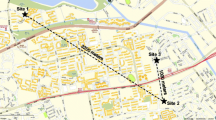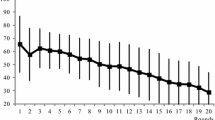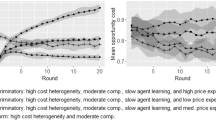Abstract
The Office National des Forêts (ONF) in France uses sequential auctions to sell a significant portion of timber from public forests. This mechanism, based on a competitive dynamic between buyers, relies on randomization at two key moments: at the start of the sale, to determine the order in which timber lots are auctioned, and at the end, to break ties between bidders who submit identical offers. This article explains why, from the sociological perspective of markets, this informal institution, which was introduced at the request of municipalities and some buyers to ensure equal treatment, is not legitimized by the ONF. It examines whether participants’ perceptions are consistent with patterns of auction prices through an empirical analysis of bid data from these sales. The article also investigates the reasons why the ONF has been randomly selecting winners in cases of tied bids for over two centuries and, more recently, with the digitalization of sales, has opted for a new market device based on the order in which offers were submitted.

Similar content being viewed by others
Data availability
The datasets generated during and/or analyzed during the current study are available from the corresponding author on reasonable request.
Code availability
The code used to analyze the data is available from the corresponding author on reasonable request. The software used was R.
Notes
The French National Forest Office (ONF) is a state-owned industrial and commercial establishment in charge of managing forests in mainland France and in French overseas departments and territories.
While, in 2005, sales by private agreements represented only 37% of the volume of timber sold, compared to 63% for the auction system (excluding individuals collecting estovers); in 2021, their share reached 59% (41% for auctions) even if sales by private agreements in value represented 48% against 52% for auctions because high-quality timber (oak, wild service trees, etc.) is mainly sold in auctions (ONF 2022). For an analysis of how market organizers were confronted with a path-dependence situation when they tried to reorganize selling methods in the beginning of the twenty-first century, see Marty (2010).
The “Grand Est” and the “Bourgogne Franche-Comté” regions are both administrative territories located in the East of France. The “Grand Est” region borders four countries (Belgium, Luxembourg, Germany, and Switzerland) and covers 57,441 km2. Located south of the latter, the “Bourgogne Franche-Comté” region borders Switzerland and covers 47,784 km2. Both regions have a rural character, and the forest represents a third of the territory.
The private sale procedure was approved by the ONF’s Board of Directors on November 29, 2018. As of 2019, it replaced the auction and competitive bidding procedures still present in the sales regulations. It differs legally because it authorizes the ONF to select the participants, knowing that it is no longer public but private. This modification offers, for example, the possibility of reserving the lots for buyers who guarantee exploitation will be carried out within the French and European sectors. On the other hand, in terms of economic theory, this procedure has the same characteristics as the first-price bid auction system.
According to data recorded on the site “ventesdebois.onf.fr,” the ONF carried out, in 2021, 231 sales sessions on tender relating to 15,699 lots of timber, i.e., an average of 68 lots per sequence. The total volume marketed per tender was 5,002,800 m3, split between timber sold standing (92%) and processed (8%).
In regions with many public forests, the agencies generally cover a department (e.g., the Metz agency for Moselle, the Epinal agency for Vosges). In areas with fewer public forests, the geographical coverage is greater (e.g., the Rennes agency for all of Brittany).
For example, in the department of Meurthe-et-Moselle, the catalog will first offer lots from the state forests of Haye, Parrot, Puvenelle, then those from the communal forests of Baccarat, Bettainvillers and end with the lots from the communal forest of Xirocourt.
Although the people interviewed indicated that they had always known about this procedure, we were unable to determine its genesis, given that it represents an informal institution that has never been mentioned in the forestry regulations.
In 2012, this challenge was the subject of a question before the Conseil d’Etat, the French highest administrative jurisdiction, of compliance with the rights and freedoms guaranteed by the Constitution of Article L-144-1 of the Forestry Code, asked by the municipality of Angles. In its decision, the Conseil d’Etat considered that, if there was, indeed, a limitation of the right of local authorities to dispose of their property, this was justified by the general interest objective of having a national forestry policy, a coherent and concerted approach, in particular with regard to the development of forest resources.
A branch manager explained to us that he did not draw lots strictly speaking but, instead, reserved the order of municipal lots and state lots to show his or her commitment to acting in the interest of the municipalities.
This label ensures that companies process or ensure the processing of oak trees purchased within the EU in order to preserve the production chains.
The results are robust to the degree of the polynomial used.
We find this same arbitration in certain wholesale fish auctions (Matras-Guin, 1987).
The sales regulations do not give any details in the event that, among the professionals to be decided upon, some may not be present in the room while the procedures for adjudication on tenders and calls for tenders authorize suppliers to tender from a distance.
We can see an illustration of this practice in the film “Les grandes gueules” directed by Roberto Enrico.
Online sales take place on the platform developed by the ONF: “ventesdebois.onf.fr”. After several series of tests in 2019, the first sale on the platform took place in Langres on January 21, 2020. Note that the ONF has committed for the moment to maintain a mixed system for the largest sales in which buyers will be able to participate in the sale from their homes or by being present in an auction room. It is a question of responding through this organization to the request of buyers to maintain social relations during sales.
The reduction in transaction costs is also important for buyers, such as stave mills, who are no longer required to travel over a large distance to attend sales.
Thanks to digitalization, buyers can participate in several sales on the same day. They no longer hesitate to take part in sessions where only a few lots may interest them.
The timestamp is a digital counter that represents an amount of time elapsed since a reference instant. For example, in the Unix system, the starting reference is January 1, 1970 (time 0).
References
Ansaloni, M., Trompette, P., & Zalio, P.-P. (2017). The market as a form of political intervention. Revue Française de Sociologie, 58(3), 359–374. https://doi.org/10.3917/rfs.583.0359
Ahrne, G., Aspers, P., & Brunsson, N. (2015). The organization of markets. Organization Studies, 36(1), 7–27. https://doi.org/10.1177/0170840614544557
Ahrne, G., & Brunsson, N. (2011). Organization outside organizations: The significance of partial organization. Organization, 18, 83–104. https://doi.org/10.1177/1350508410376256
Ashenfelter, O. (1989). How auctions work for wine and art. The Journal of Economic Perspectives, 3(3), 23–36. https://doi.org/10.1257/jep.3.3.23
Ashenfelter, O., & Genesove, D. (1992). Testing for price anomalies in real-estate auctions. American Economic Review: Papers and Proceedings, 82(2), 501–505.
Aspers, P. (2013). Quality and temporality in timber markets. In: Jens Beckert & Christine Musselin (eds.), Constructing quality: The classification of goods in markets, pp. 58–76. Oxford University Press.
Beggs, A., & Graddy, K. (1997). Declining values and the afternoon effect: Evidence from art auctions. RAND Journal of Economics, 28, 544–565.
Bonnain, R., & De la Pradelle, M. (1987). Place et rôle du hasard sur les marchés. Ethnologie Française, 17(2/3), 235–244.
Boutefeu, B. (2002). La réforme de l’Office national des Forêts : Quelles conséquences pour les forestiers publics et leur système de valeurs ? Revue Forestière Française, 60(6), 691–709. https://doi.org/10.4267/2042/28368
Branco, F. (1997). Sequential auctions with synergies: An example. Economic Letters, 54, 159–163. https://doi.org/10.1016/S0165-1765(97)00013-X
Bromberger, C., & Ravis-Giordani, G. (1987). Penser, agir et jouer avec le hasard. Ethnologie Française, 17(2/3), 128–136.
Catani, M. (1987). Tirage au sort et « apprezzatori » dans un village du Bas Salento (Pouilles, Italie). Ethnologie Française, 17(2/3), 277–284.
Cohen, E., Mougeot, P. (2001). Enchères et gestion publique, collection du Conseil d’Analyse Economique, 34, La Documentation française. https://www.vie-publique.fr/rapport/25114-encheres-et-gestion-publique. Accessed 21 Nov 2022.
Cour des Comptes. (2020). La structuration de la filière forêt-bois, ses performances économiques et environnementales, Communication à la commission des finances, de l’économie générale et du contrôle budgétaire de l’Assemblée nationale. https://www.ccomptes.fr/fr/publications/la-structuration-de-la-filiere-foret-bois. Accessed 21 Nov 2022.
Deltas, G. (1999). Auction size and price dynamics sequential auctions. Bureau of Economics & Business Research, Working Paper No. 98–0117. Urbana- Champaign: University of Illinois, Department of Economics.
Deltas, G., & Kosmopoulou, G. (2004). ‘Catalogue’ vs ‘Order-of-sale’ effects in sequential auctions: Theory and evidence from a rare book sale. Economic Journal, 114(492), 28–54. https://doi.org/10.1046/j.0013-0133.2003.00175.x
Dequiedt, V. (2006). La communication d’informations au cours des ventes aux enchères de bois par adjudication : Ce que dit la théorie économique. Revue Forestière Française, 58(5), 478–482. https://doi.org/10.4267/2042/6772
Dubuisson-Quellier, S. (2016). Gouverner les conduites. Presses de Sciences Po. https://doi.org/10.3917/scpo.dubui.2016.01.
Eloire, F. & Finez, J. (2021). Sociologie des prix. La Découverte.
Engelbrecht-Wiggans, R. (1994). Sequential auctions of stochastically equivalent goods. Economic Letters, 44, 87–90.
Escande-Vilbois, S., & Lacroix, P. (2002). Les budgets des communes forestières en crise. Revue Forestière Française, 53(NS), 103–110. https://doi.org/10.4267/2042/5003
François, P. (2011). Vie et mort des institutions marchandes. Presses de Sciences Po.
Gandal, N. (1997). Sequential auctions of interdependent objects: Israeli cable television licenses. Journal of Industrial Economics, 45(3), 227–244. https://doi.org/10.1111/1467-6451.00047
Garcia-Parpet, M.-F. (1986). La construction sociale d’un marché parfait : Le marché au cadran de Fontaines-en-Sologne. Actes de la Recherche en Sciences Sociales, 65, 3–15. https://doi.org/10.3406/arss.1986.2347
Jeitschko, T. D. (1999). Equilibrium price paths in sequential auctions with stochastic supply. Economics Letters, 64, 67–72.
Karpik, L. (2010). Valuing the unique: The economic of singularities. Princeton University Press. https://doi.org/10.2307/j.ctv1zm2v2n
Lambson, V. E., & Thurston, N. K. (2006). Sequential auctions: Theory and evidence from the seattle fur exchange. RAND Journal of Economics, 37(1), 70–80. https://doi.org/10.1111/j.1756-2171.2006.tb00004.x
Loisier, A-C. (2019). Rapport d’information n° 563 (2018–2019). Fait au nom de la commission des affaires économiques, June 12, 2019. https://www.senat.fr/notice-rapport/2018/r18-563-notice.html. Accessed 21 Nov 2022.
Lusht, K. (1994). Order and price in a sequential auction. Journal of Real Estate Finance and Economis, 8, 259–266. https://doi.org/10.1007/BF01096996
Marty, G. (2010). Path dependence in merchant institutions: The case of French public timber sales. In G. Schreyögg, J. Sydow (Eds.), The hidden dynamics of path dependence: Institutions and organizations, 1st ed., (pp. 148–160). Palgrave Macmillan. https://doi.org/10.1057/9780230274075
Marty, G. (2015). Le catalogue des ventes de l’ONF. Un commis forestier au format papier ? Revue d’Anthropologie des connaissances, 9(1), 83–100. https://doi.org/10.3917/rac.026.0083
Marty, G. (2015b). « Juste » prix et réputation professionnelle : Un double enjeu pour les enchères de bois public. Ethnologie Française, 45, 735–744. https://doi.org/10.3917/ethn.154.0735
Matras-Guin, J. (1987). Vente aux enchères et tirage au sort dans les criées en gros du poisson. Ethnologie Française, 17(2/3), 227–234.
McAfee, P., & Vincent, D. (1992). Updating the reserve price in common value auction. American Economic Review, 82(2), 512–518.
Menezes, F., & Monteiro, P. (2003). Synergies and price trends in sequential auctions. Review of Economic Design, 8(1), 85–98.
Muniesa, F., Millo, Y., & Callon, M. (2007). An introduction to market devices. The Sociological Review, 55(2_suppl), 1–12. https://doi.org/10.1111/j.1467-954X.2007.00727.x
Nee, V. (2010). The new institutionalisms in economic sociology. In N. J. Smelser & R. Swedberg (Eds). The handbook of economic sociology, 2nd ed., (pp. 49–74). Princeton University Press. https://www.jstor.org/stable/j.ctt2tt8hg.7
Office National des Forêts. (2008). Sales of timber from public forest. Essential provisions and regulations. Retrieved from https://www.onf.fr/onf/conditions-generales-de-vente/+/2f::ventes-de-bois-et-achat-de-services-dexploitation-forestiere-ce-que-dit-la-loi.html. Accessed 21 November 2022.
Office national des forêts D. C. B. (2022). Les ventes de bois des forêts publiques en 2021. Revue Forestière Française, 73(6), 665–679. https://doi.org/10.20870/revforfr.2021.7207
Orléan, A. (2003). Réflexion sur les fondements institutionnels de l’objectivité marchande. Cahiers d’Économie Politique, 44, 181–196. https://doi.org/10.3917/cep.044.0181
Pitchik, C., & Schotter, A. (1988). Perfect equilibria in budget-constrained sequential auctions: An experimental study. RAND Journal of Economics, 19, 363–388.
Rilinger, G. (2022). Conceptual limits of performativity: Assessing the feasibility of market design blueprints, Socio-Economic Review, 1–24. https://doi.org/10.1093/ser/mwac017
Smith, C. (1989). The social construction of value. University of California Press.
Vanderporten, B. (1992). Timing of bids at pooled real estate auctions. Journal of Real Estate Finance and Economics, 5(3), 255–267. https://doi.org/10.1007/BF02341913
Velthuis, O. (2003). Symbolic meanings of prices: Constructing the value of contemporary art in Amsterdam and New York galleries. Theory and Society, 32, 181–215. https://doi.org/10.1023/A:1023995520369
von der Fehr, N. (1994). Predatory bidding in sequential auctions. Oxford Economic Papers, 46, 345–356. https://doi.org/10.1093/oxfordjournals.oep.a042134
Yakubovich, V., Granovetter, M., & Mcguire, P. (2005). Electric charges: The social construction of rate systems. Theory and Society, 34, 579–612. https://doi.org/10.1007/s11186-005-4198-y
Author information
Authors and Affiliations
Contributions
All authors contributed to the study conception and design. The first draft of the manuscript was written by GM, and all the authors commented on previous versions of the manuscript. The econometrics analysis of the data was performed by EC. All the authors read and approved the final manuscript.
Corresponding author
Ethics declarations
Ethics approval
Not applicable.
Consent to participate
Not applicable.
Consent for publication
Not applicable.
Conflict of interest
The authors declare no competing interests.
Additional information
Publisher's note
Springer Nature remains neutral with regard to jurisdictional claims in published maps and institutional affiliations.
Rights and permissions
Springer Nature or its licensor (e.g. a society or other partner) holds exclusive rights to this article under a publishing agreement with the author(s) or other rightsholder(s); author self-archiving of the accepted manuscript version of this article is solely governed by the terms of such publishing agreement and applicable law.
About this article
Cite this article
Caoui, E.H., Marty, G. Random drawing in sequential auctions: investigating the role of a market device in timber sales. Rev Agric Food Environ Stud 104, 101–122 (2023). https://doi.org/10.1007/s41130-022-00184-0
Received:
Accepted:
Published:
Issue Date:
DOI: https://doi.org/10.1007/s41130-022-00184-0




